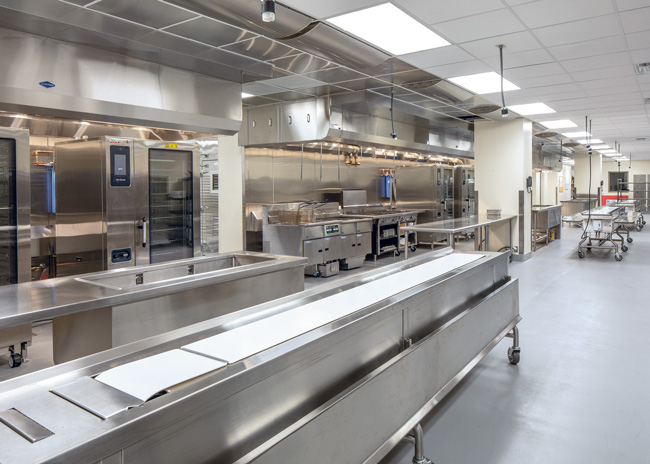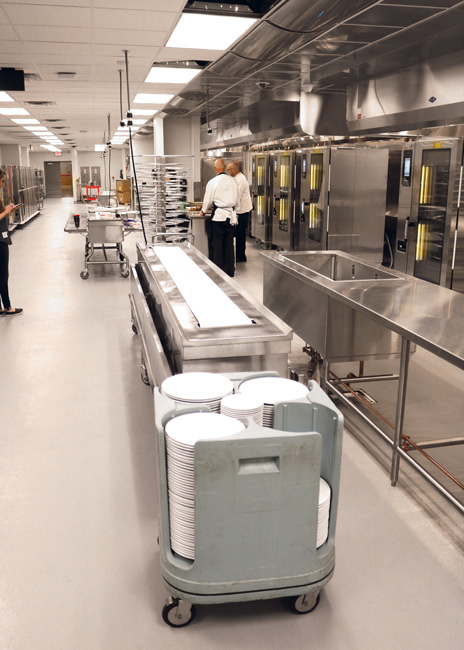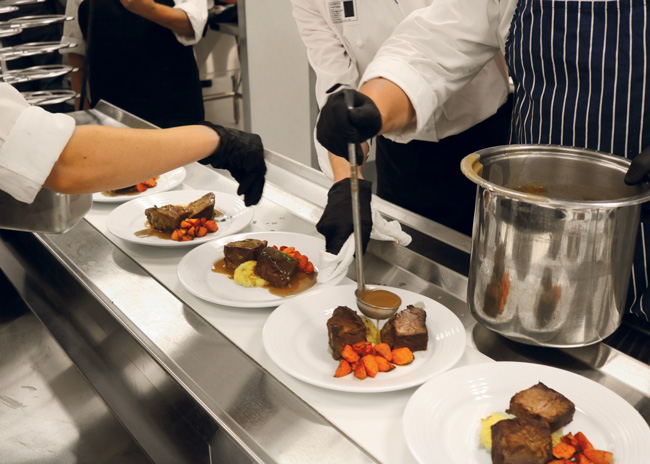Versatility is needed to accommodate different event types.
 Banquet kitchens require ample space to move and plate items. Photo courtesy of Cunningham Design GroupWhile restaurant needs are often static and predictable, the same cannot be said for banquets and catered events. A kitchen may need to accommodate a large wedding with plated service or a smaller-sized meeting that has a self-serve buffet. Just as the needs of restaurant and banquet kitchens are different, so are the kitchen designs.
Banquet kitchens require ample space to move and plate items. Photo courtesy of Cunningham Design GroupWhile restaurant needs are often static and predictable, the same cannot be said for banquets and catered events. A kitchen may need to accommodate a large wedding with plated service or a smaller-sized meeting that has a self-serve buffet. Just as the needs of restaurant and banquet kitchens are different, so are the kitchen designs.
“Catering kitchens are more prep oriented, while a banquet kitchen has a serpentine setup,” says Chris Harkness, chief operations officer, Great Performances, a catering, event and hospitality firm based in the Bronx, N.Y. “For both, flow is as important as mobility, with everything moving from left to right with production.”
Banquet kitchens need to be adaptable as staff will execute different methods of cooking and prep in this space to accommodate the various events and different needs. “The goal of banquet kitchens is to provide a remote foodservice serving area and to get a large amount of food out quickly,” says Cory Moe, senior designer, Special Projects Group, TriMark, Irvine, Calif.
Banquet kitchens also can differ based on location. For example, the design for a restaurant banquet kitchen would differ from that of a large hotel or convention center. “Banquet kitchens also can serve as central production for other venues,” says Steve Carlson, president of Rippe Associates, headquartered in Minneapolis.
Critical Components and Elements
With so many kitchen variations, the project team should take into account a number of factors before designing a banquet kitchen. These factors include the type of events the venue will host, capacity of meeting rooms or event space and the style of service, such as plated, boxed or buffet. “The number of people that will be served at one time influences the capacity of the finish cooking and plating area,” Carlson says. “This also influences the size of the storage areas.”
 Adaptability in banquet kitchens is key since staff will execute different cooking and prep methods to accommodate various events and needs. Photo by Mike Wrase, Rippe AssociatesFirst and foremost, consider the size and location of the banquet kitchen. “We look at the space and delivery of product to that space,” Moe says. “Where the food is coming in and out, how the buffet is serviced and whether there is room for a walk-in or reach-in refrigeration makes a difference in the design.”
Adaptability in banquet kitchens is key since staff will execute different cooking and prep methods to accommodate various events and needs. Photo by Mike Wrase, Rippe AssociatesFirst and foremost, consider the size and location of the banquet kitchen. “We look at the space and delivery of product to that space,” Moe says. “Where the food is coming in and out, how the buffet is serviced and whether there is room for a walk-in or reach-in refrigeration makes a difference in the design.”
The overall size of the space will determine how best to sequence the equipment so staff can effectively serve the food. “Like with any design, we look at the different parameters to see where receiving is, how food will be moved through and where servers are coming in and out,” Moe explains.
Project teams should take into account other, less obvious factors, too. “Making sure there is enough electricity available as well as ways to keep food hot and designating a staging area are important,” Harkness notes. “Everything must be able to shift to handle different types of events, which have varying requirements. For example, a seated dinner will need space for plating food.”
In addition to storage that can accommodate the maximum meals served per event, Carlson says a bulk/batch production prep area is essential, along with a finish cooking and plating area that can flex from cook, plate, serve to cook, plate, chill, retherm and serve.
As with most back-of-the-house designs, the layout and setup stem from grasping the operation’s needs beforehand. “The extent of the banquets — whether it’s one or multiple spaces that will be serviced at one time — will dictate the design,” Moe says. “Equipment tends to stay consistent with banquet kitchens. And though storage is one of the most important aspects, it tends to get shortchanged.”
Moe adds, “Banquet kitchens can have different components, too. For instance, a hotel may have a dedicated cooking area in addition to a restaurant foodservice line.”
A key consideration is making sure the kitchen can accommodate the maximum volume of food that staff will prepare at one time. “Will the kitchen be servicing one wedding at a time or multiple event spaces? And will food be brought on an elevator or stairs? And is the kitchen adjacent to the space?” asks Arlene Spiegel, founder and president, Arlene Spiegel & Associates, New York City.
The Layout & Logistics
The most successful banquet kitchens are located as close as possible, with back-of-the-house access to the event spaces. “In addition, the ballroom back-of-the-house corridor must be wide enough to accommodate final plate out, bussing and beverages,” Carlson says. “The ‘engine’ or prep cooking and final plating is centered between storage and dishwashing.” There must be sufficient length for the plating area and soiled dish drop for direct access to the back-of-the-house corridor, he adds.
The design should include some convenience factors, too. “Recessed floors into the walk-in coolers allow smooth transitions,” Carlson says. “And [ideally] the kitchen’s location should be adjacent to the receiving dock.”
The design requirements of a restaurant’s banquet back of the house may differ from those of a dedicated event kitchen. “For a restaurant holding banquets, there may be an area with mobile tables located away from the main service line where food is dished up,” Moe says. “So, it’s the size and scale that determine the design. Many times, if there is a large, multifunction area with various meeting rooms and events happening at the same time, like at a resort, the banquets area can be connected or cordoned off.”
In many cases, banquet kitchen design starts with the receiving area. “This is true especially with high-volume cooking like banquets, because an enormous amount of product will be delivered at one time,” Spiegel explains. “We also look at whether there is a loading dock and a special receiving area with a scale to weigh items.”
Product will then go into a freezer, a refrigerator or an ambient storage area. “A well-designed receiving area will allow for large volumes of product to be stored quickly and easily,” Spiegel says.
Operators should designate and design specific areas for each task. This may require multiple pieces of the same equipment when necessary. “[During events], staff cannot be held up waiting for someone to finish using the grill or oven,” Harkness notes. “For hotels, it’s best to have the banquet kitchen separate from the a la carte kitchen, although sometimes one is behind the other.”
The space available will dictate a banquet kitchen’s placement. “In some cases, the banquet kitchen may be located behind the hot line or on a different floor,” Harkness says. “And in some operations, a space may be designated for prep during the day and turn into banquet space at night.”
Kitchen Components
In terms of stations, banquet kitchens handling cooking and prep will require a hot line, pantry and cold prep area. For seated dinners, Harkness recommends one 6-foot table for every 100 guests.
“We need an area to tray things up if it’s going to be a la carte service,” Spiegel says. “Prime rib, roast chicken or broiled salmon would be trayed up and ready for combi ovens, then put in hot or cold units for finishing and direct plating for guests.”
The main components include refrigerated storage, a staging area for heated holding with mobile heated cabinets, dish-up areas with mobile tables, a beverage service area for water, tea, coffee and soft drinks; and possibly a warewashing area, Moe notes.
 A spacious plating area ensures speed of service is not impacted during large-scale events. Photo by Mike Wrase, Rippe AssociatesAccording to Moe, the majority of the banquet kitchens he’s worked with don’t have a cooking area. “These mainly are just a place for hot and cold food holding and staging,” he says.
A spacious plating area ensures speed of service is not impacted during large-scale events. Photo by Mike Wrase, Rippe AssociatesAccording to Moe, the majority of the banquet kitchens he’s worked with don’t have a cooking area. “These mainly are just a place for hot and cold food holding and staging,” he says.
Kosher banquet kitchens must separate dairy and meat products from pareve products, of course, but there also are strict rules about handling vegetables, as these have to be washed in a certain way to be certified kosher, Spiegel notes.
“Plate and glass storage areas are required as well as an auxiliary area for tables, chairs, etc., in a separate space,” Moe says.
Along with storage areas for plates, glassware, utensils, tables, chairs and linens, there may be a separate space for holding refrigerated alcoholic beverages as well as a locked storage area for ambient alcohol, Spiegel says. “Room for rolling carts to finishing areas is needed,” she adds. “And rolled carts can be used as mobile bars, if needed.”
Washing is a primary consideration with banquet kitchens, and there can be different iterations. The boards of health require sinks dedicated to pot washing, produce washing and handwashing. The appropriate size and number of each kind of washing station will depend on the volume of service at one time. “There should be a warewashing area for pots, pans and all elements used for cooking and prep,” Spiegel says. “For items that need to be washed by hand, a three-compartment sink that is large enough to hold the largest tray or pan being used is necessary.”
Banquets that have a dedicated bakery program will need a designated cold room. “This is because main kitchens can get too hot and humid,” Spiegel says. “These programs may need a series of induction stoves. Those buying frozen product will need a proofer. I also recommend combi ovens, which are multifunctional.”
Banquet kitchens often include other unique attributes. “The entire area of the back of house needs a changing room and lockers for staff,” Spiegel says. “It’s also good to have an employee bathroom and handwashing area.”
The type and amount of equipment are dependent on the space available, volume and menu. “We often list generic pieces and describe the location,” Carlson says. “For example: The banquet’s pastry kitchen includes three floor mixers, two prep tables and two combi ovens staff use for baking breads. Roll-in blast chillers and roll-in combi ovens are used for plate chilling and retherm. Large kettles and tilt fry pans especially are used in high-capacity banquet kitchens. We include flight-type dish machines and separate dish machines for glassware.”
Multifunctional equipment can help make the most of a banquet kitchen’s capabilities and space. “The things we’re seeing a lot more of are combi ovens that can produce large amounts of food quickly,” Moe says. “The staple equipment is still heated cabinets and walk-in or roll-in refrigerators.”
Harkness agrees that adding combi ovens to the design can increase banquet kitchen efficiency. “These ovens can hot hold and reheat, so we’re seeing them more in banquet kitchens,” he says. “But overall, banquets are straightforward events. Having appropriate space and proper mobility are the most important aspects of banquet kitchens.”




